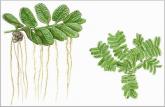Floating Fern - Salvinia natans
This free-floating graceful fern spreads out over the surfaces of stagnant or slow-flowing fresh waters. It consists of a thin horizontal stem (but sometimes three or four) no longer than 8-10 cm long, bearing 6-14 small elliptical leaves, arranged equally on the two opposite sides.
Their characteristic herringbone arrangement has given them their common Italian name of "Erba Pesce" = Fish Grass.
The upper blade of each leaf is covered with short hairs, giving it a velvety look, and which probably serve to waterproof and protect it. A third leaf departs from the node of each pair of floating leaves, which takes on the shape and function of a root.
These totally transformed leaves enable the little fern to absorb the nutrients it needs to survive directly from the water. The spherical sporocarps develop on the under surface of the plant, in contact with the water, and are arranged in small bunches.
These contain the spores, ready to fall onto the mud at the bottom where they survive the harsh conditions of winter.
Until forty years ago, it was common to see this floating fern, especially in the paddy fields of the Po Valley, although it was rare elsewhere.
Today it is under threat everywhere because of the eutrophication of the water, of which it is a sensitive biological indicator. Its occurrence in the Fucecchio Marshes is cyclic - some years it is abundant, but others is practically impossible to find; it was last reported in the mid-nineties.




